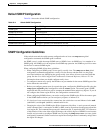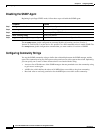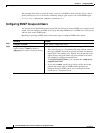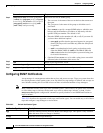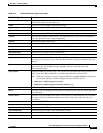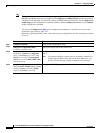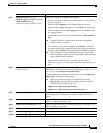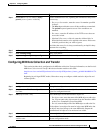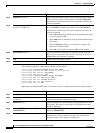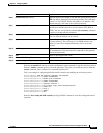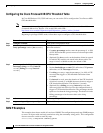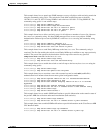
29-15
Cisco ME 3400 Ethernet Access Switch Software Configuration Guide
OL-9639-06
Chapter 29 Configuring SNMP
Configuring SNMP
Step 5
snmp-server host host-addr
[informs | traps] [version {1 | 2c | 3
{auth | noauth | priv}}]
community-string [notification-type]
Specify the recipient of an SNMP trap operation.
• For host-addr, specify the name or Internet address of the host (the
targeted recipient).
• (Optional) Enter informs to send SNMP informs to the host.
• (Optional) Enter traps (the default) to send SNMP traps to the host.
• (Optional) Specify the SNMP version (1, 2c, or 3). SNMPv1 does
not support informs.
• (Optional) For Version 3, select authentication level auth, noauth, or
priv.
Note The priv keyword is available only when the cryptographic
software image is installed.
• For community-string, when version 1 or version 2c is specified,
enter the password-like community string sent with the notification
operation. When version 3 is specified, enter the SNMPv3 username.
Note The @ symbol is used for delimiting the context information.
Avoid using the @ symbol as part of the SNMP community string
when configuring this command.
• (Optional) For notification-type, use the keywords listed in
Table 29-5 on page 29-12. If no type is specified, all notifications are
sent.
Step 6
snmp-server enable traps
notification-types
Enable the switch to send traps or informs and specify the type of
notifications to be sent. For a list of notification types, see
Table 29-5 on
page 29-12, or enter snmp-server enable traps ?
To enable multiple types of traps, you must enter a separate snmp-server
enable traps command for each trap type.
Note When you configure a trap by using the notification type
port-security, configure the port security trap first, and then
configure the port security trap rate:
• snmp-server enable traps port-security
• snmp-server enable traps port-security trap-rate rate
Step 7
snmp-server trap-source interface-id (Optional) Specify the source interface, which provides the IP address for
the trap message. This command also sets the source IP address for
informs.
Step 8
snmp-server queue-length length (Optional) Establish the message queue length for each trap host. The
range is 1 to 1000; the default is 10.
Step 9
snmp-server trap-timeout seconds (Optional) Define how often to resend trap messages. The range is 1 to
1000; the default is 30 seconds.
Step 10
end Return to privileged EXEC mode.
Step 11
show running-config Verify your entries.
Step 12
copy running-config startup-config (Optional) Save your entries in the configuration file.
Command Purpose



